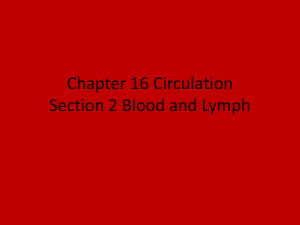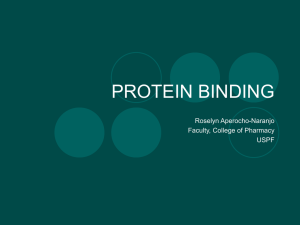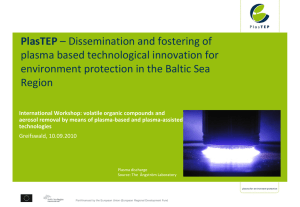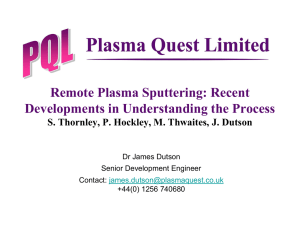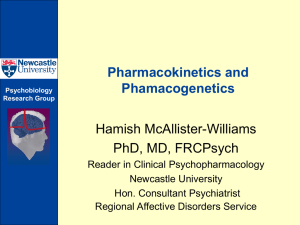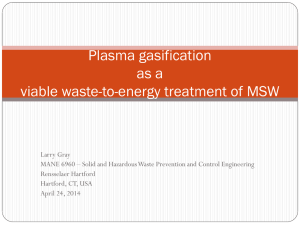File
advertisement
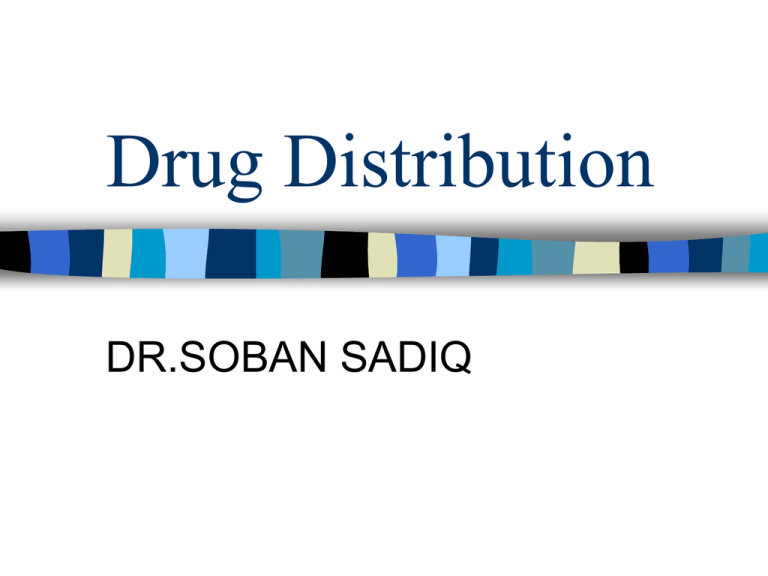
Drug Distribution DR.SOBAN SADIQ Definition It is the process by which a drug reversibly leaves the blood stream and enters the interstitial fluid and/or the cells of the tissues Apparent Volume of Distribution (Vd) A hypothetical volume of fluid into which a drug disseminates. Although the Vd has no physiologic or physical basis,it is some times useful to compare the distribution of a drug with the volumes of the water compartments in the body Formula for Vd It is calculated as the total amount of drug in the body divided by the concentration of the drug in plasma Vd = total dose administered = D plasma concentration C Distribution of Drugs in Various Body Compartments 70kg Adult Total Body Water = 42 Liters ICF = 2/3 = 28 Liters ECF = 1/3 = 14 Liters Of the ECF: Interstitial Volume = 10 Liters Plasma Volume = 4 Liters Plasma Compartment If a drug has a very large molecular weight or binds extensively to plasma proteins, it is too large to move out through the endothelial slit junctions of capillaries, thus restricted within the vascular compartment e.g Warfarin So Vd = 4L Protein binding Extracellular Fluid If a drug has a low molecular weight but is hydrophilic (lipid insoluble), it can move through the endothelial slit junctions of capillaries into the interstitial fluid but cannot enter into the cells (e.g Mannitol) Therefore Vd = ECF Volume (plasma volume + Interstitial fluid volume) = 4+10 =14 L Total Body Water If a drug has a low molecular weight and is hydrophobic (lipid soluble), it can move into the interstitial fluid as well as can enter cells Thus it distributes into total body water = 42 Liters E.g. Alcohol Factors affecting Distribution Blood Flow This is an important determinant of the rate of uptake of drug. Drugs are first taken up by highly perfused tissues (e.g. brain, heart) and these tissues will often achieve high tissue concentrations more rapidly than poorly perfused tissues (e.g. fat, bone). Size of the Organ Organs of large size take up large amount of drug driven by the concentration gradient Organs of smaller size: distribution of only small amount of drug into it will raise the tissue concentration Lipid: Water Partition Coefficient Drugs that are highly lipid soluble will readily cross cell membranes and thus be more distributed And lipid soluble drugs also more readily cross special barriers such as the blood brain barrier as well as the placental barrier. Binding Binding of a drug to macromolecules in the blood (plasma proteins) or a tissue compartment will tend to increase the drug’s concentration in that compartment. Other Factors Fat: Lean Body Mass Ratio: Those people having high Fat:Lean body mass ratio will have less distribution of the drug Pregnancy: During pregnancy the fetus may take up drugs and thus increase distribution of the drug Pathological States Congestive Heart Failure: (alteration of body water) Cirrhosis of Liver: Decreased synthesis of plasma proteins Uremia: Accumulation of Metabolites that displace drugs from binding sites Plasma Protein Binding After absorption, the drug circulates in the blood either in the free form or bound to plasma proteins. This binding is reversible. These drugs are inert in (Pharmacologically inactive) bound form Only the free form is pharmacologically active Bound form of the drug is not easily metabolized or excreted So plasma proteins act as a reservoir or temporary storage place Clinical Significance 1. When TWO drugs are given, each with a high affinity for plasma protein, they compete for the available binding sites If a patient who is taking 1 Drug e.g. Tolbutamide which is normally 95% bound is given II Drug e.g. Sulfonamide which has higher affinity for the plasma protein This II drug will now displace the I Drug This will lead to a rapid increase in concentration of free drug (active drug) in the plasma (Now 100% free) 2. In hypoalbuminemia, binding may be reduced and high concentrations of free drug may be attained e.g. Phenytoin and Frusemide 3. Drugs that are highly plasma protein bound may have a longer duration of action and hence longer half life because the drugs in bound form cannot be metabolized or excreted. Thus they require less frequent dosing. 1-The following factor tends to reduce drug distribution A-High lipid solubility B-Low ionization at physiological ph values C-High plasma protein binding D-High tissue binding 2-The volume of distribution (Vd) relates: A- Single to a daily dose of an administrated drug B- An administrated dose to a body weight C- An uncharged drug reaching the systemic circulation D-The amount of a drug in the body to the concentration of a drug in plasma 3-For the calculation of the volume of distribution (Vd) one must take into account: A-Concentration of a substance in plasma B-Concentration of substance in urine C-Therapeutical width of drug action D- A daily dose of drug 4-Which of the following factor increases the drug distribution A-decrease blood flow B-decrease lipid –water partition coefficient C-decrease size of the organ D-decrease plasma protein binding 5-High plasma protein binding: A-Increase Vd of the drug B-Facilitates glomerular filtration of the drug C-Minimises drug interactions D-Generally makes the drug long acting 6-The plasma protein bound fraction of a drug: A-contributes to the response at the given moment B-remains constant irrespective of the total drug concentration C-remains constant irrespective of the disease state D-is not available for metabolism



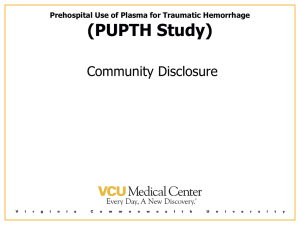
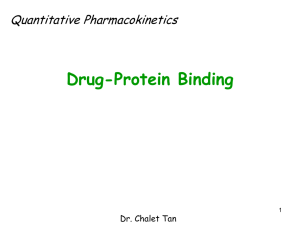
![PHT414 [ Lec. 4] Drug distribution Alteration of drug distribution and](http://s3.studylib.net/store/data/007354790_1-f154f11cc33ccc757a4c59622936a98b-300x300.png)
